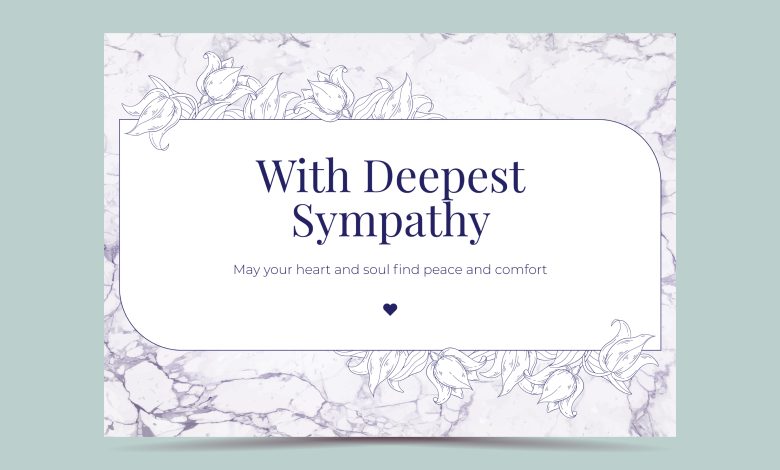The Significance of Thoughtful Sympathy Cards

In times of loss and sorrow, receiving sympathy cards carries deep significance beyond their simple words or designs. When mourning the passing of a loved one, we frequently feel insulated in our grief as though we’re the only bones left to carry this heavy sadness. A thoughtful card serves as a memorial that we aren’t alone.
By taking the time to elect, subscribe, and shoot a card, the gesture communicates that another person sees our pain and shares in our suffering. It says,” I may not completely understand what you are going through, but I want you to know that I am allowing you and your family during this delicate time.” further than anything, it lets the deprived know that their loved one, while physically gone, still leaves behind cherished memories in the hearts of those whose lives they touched.
Thoughtfully chosen cards are also significant in aiding the healing process. Beyond words of condolence, many provide space to journal memories or include guidance on coping. This normalizes grieving as a journey, not something to rush through or suppress. It gives hope that the deep ache will eventually soften into a quiet remembering of brighter days.
Months after the funeral, when outside support fades, thoughtful cards maintain a lifeline. Their arrival is a ray of light, reminding us that though alone, we are not forgotten. Simple messages reiterating caring thoughts still uplift weary souls. In this way, cards continue communally easing sorrow’s load long after the initial loss.
Whether near or far, cards affirm that even across distances, the community embraces all who grieve. Their significance lies not in extravagance but in perception – seeing through a mourner’s eyes what gesture will truly comfort. A tangible token honors both life and loss, sacred bonds between all people. In the darkness, cards bring solace by shining light on our shared human ability to lessen sorrow through shared compassion. In this way, their thoughtful giving grants lasting significance.
The Gift of Memories
Beyond comforting words, sympathy cards hold significance by encouraging acts of remembrance. They provide space to journal treasured memories that may bring both tears and smiles. This aids the grieving process by allowing mourners to actively grapple with their loss by committing fond moments to paper.
Revisiting memories through writing helps solidify them so they can never fully fade, preserving part of the deceased’s essence for generations to come. Family members may then cherish reading how their loved one touched others’ lives. Over time, documentation of memories accumulated in cards becomes a meaningful archive of that individual’s legacy.
A Tangible Tether to Community
For those bereaved living at a distance, the significance of receiving cards lies in their ability to maintain a tangible tether to community support networks. In times of sorrow, it is all too easy to feel isolated by physical and emotional walls erected by grief. A sympathetic card’s arrival punctures that isolating bubble by loudly proclaiming, “You are still connected – your sorrow is known and felt elsewhere.”
Its physicality offers solace far beyond computer screens by providing a haptic reminder suitable for unfolding and revisiting in quiet moments. Cards become touchstones summoning up thoughts and prayers of faraway loved ones. This acts as a powerful counterforce against loneliness, reaffirming one’s belonging even when disconnected by vast distances.
Marks of Respect
Perhaps most importantly, sympathy cards significantly demonstrate reverence for the life that was lived and lost. Thoughtfully selecting an appropriate message and taking time to handwrite caring sentiments shows respect for both the deceased and the bereaved family.
In a world where responsibilities sometimes dull compassion, cards remind us to slow down and acknowledge sorrow – that lives matter, and merit active remembrance even after passing. This honoring of a soul’s legacy provides meaningful solace and helps mourners maintain dignity during their vulnerability.
History
The history of sympathy cards dates back over a century. In the Victorian era of the late 1800s, bereavement etiquette dictated formal rules of mourning through which people externally displayed their grief. Sending condolence letters and funeral flowers became standard practices to offer respect and consolation. Around the turn of the 20th century, advancements in printing made it possible to mass-produce pre-printed bereavement cards at affordable prices. This paved the way for sympathy cards to become a mainstream and accessible way for the community to connect with and support the grieving.
Today, a wide assortment of sympathy cards are available at most drugstores, supermarkets, card shops, and online retailers. Cards range from religious to secular themes, with sentiments to suit all beliefs and relationships with the deceased. Popular messages include quotes about fond memories living on, Bible passages offering hope, and words emphasizing that the sender’s thoughts are with the mourner. Styles include photo cards with nature scenes or images symbolic of remembrance, as well as more traditional designs featuring doves, angels, or flowers. Handwritten cards allow for a personal, heartfelt note to be inserted.



